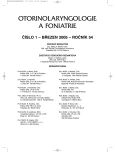Peroperation Electromyographic Monitoring in Cranial Base Surgery
Authors:
P. Vachata; M. Sameš; J. Ceé; R. Bartoš
Authors‘ workplace:
Neurochirurgické oddělení, Masarykova nemocnice, Ústí nad Labem
přednosta oddělení prim. MUDr. M. Sameš, CSc.
Published in:
Otorinolaryngol Foniatr, 54, 2005, No. 1, pp. 3-9.
Category:
Original Article
Overview
Summary:
One of the goals of cranial base surgery is to save functional integrity of head nerves and thereby to prevent serious postoperation complications. The peroperation electromyography is based on recording evoked and spontaneous activity from muscles innervated with individual nerves. The monitoring helps the surgeon to improve orientation in the operation field and to localize the course of the nerve even in anatomically changed conditions. The peroperation EMG demonstrably improves functional results and decreases the total period of operation. The presence of preserved evoked EMG response together with its electrophysiological characteristics (amplitude, latency, minimal stimulation threshold) may be used for prediction of postoperation function.
Key words:
electromyography, peroperation monitoring, cranial base surgery.
Labels
Audiology Paediatric ENT ENT (Otorhinolaryngology)Article was published in
Otorhinolaryngology and Phoniatrics

2005 Issue 1
Most read in this issue
- Relapsing Middle Cervical Cyst and Atypical Position of Hyoid Bone
- Central Hearing Loss in Children with Developmental Dysphasia
- Testing Olfaction Merkers by Means of Perfumed
- Present Classification of Laser Cordectomy
